The Intel Core i9-9990XE Review: All 14 Cores at 5.0 GHz
by Dr. Ian Cutress on October 28, 2019 10:00 AM ESTCPU Performance: Web and Legacy Tests
While more the focus of low-end and small form factor systems, web-based benchmarks are notoriously difficult to standardize. Modern web browsers are frequently updated, with no recourse to disable those updates, and as such there is difficulty in keeping a common platform. The fast paced nature of browser development means that version numbers (and performance) can change from week to week. Despite this, web tests are often a good measure of user experience: a lot of what most office work is today revolves around web applications, particularly email and office apps, but also interfaces and development environments. Our web tests include some of the industry standard tests, as well as a few popular but older tests.
We have also included our legacy benchmarks in this section, representing a stack of older code for popular benchmarks.
All of our benchmark results can also be found in our benchmark engine, Bench.
WebXPRT 3: Modern Real-World Web Tasks, including AI
The company behind the XPRT test suites, Principled Technologies, has recently released the latest web-test, and rather than attach a year to the name have just called it ‘3’. This latest test (as we started the suite) has built upon and developed the ethos of previous tests: user interaction, office compute, graph generation, list sorting, HTML5, image manipulation, and even goes as far as some AI testing.
For our benchmark, we run the standard test which goes through the benchmark list seven times and provides a final result. We run this standard test four times, and take an average.
Users can access the WebXPRT test at http://principledtechnologies.com/benchmarkxprt/webxprt/
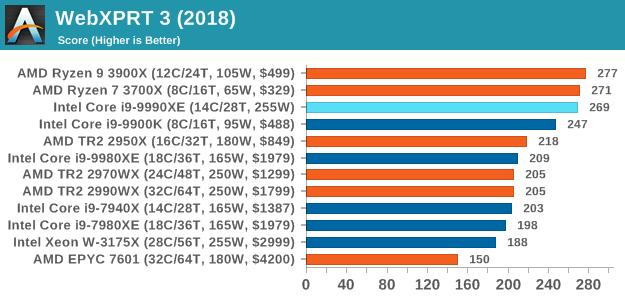
WebXPRT 2015: HTML5 and Javascript Web UX Testing
The older version of WebXPRT is the 2015 edition, which focuses on a slightly different set of web technologies and frameworks that are in use today. This is still a relevant test, especially for users interacting with not-the-latest web applications in the market, of which there are a lot. Web framework development is often very quick but with high turnover, meaning that frameworks are quickly developed, built-upon, used, and then developers move on to the next, and adjusting an application to a new framework is a difficult arduous task, especially with rapid development cycles. This leaves a lot of applications as ‘fixed-in-time’, and relevant to user experience for many years.
Similar to WebXPRT3, the main benchmark is a sectional run repeated seven times, with a final score. We repeat the whole thing four times, and average those final scores.
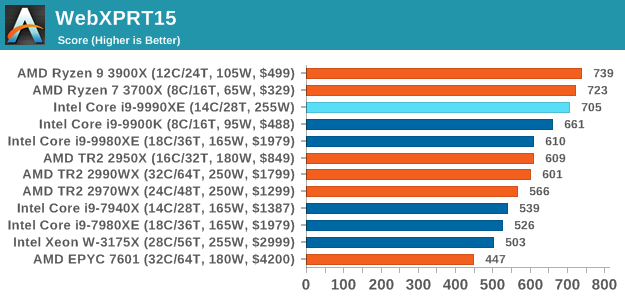
Speedometer 2: JavaScript Frameworks
Our newest web test is Speedometer 2, which is a accrued test over a series of javascript frameworks to do three simple things: built a list, enable each item in the list, and remove the list. All the frameworks implement the same visual cues, but obviously apply them from different coding angles.
Our test goes through the list of frameworks, and produces a final score indicative of ‘rpm’, one of the benchmarks internal metrics. We report this final score.
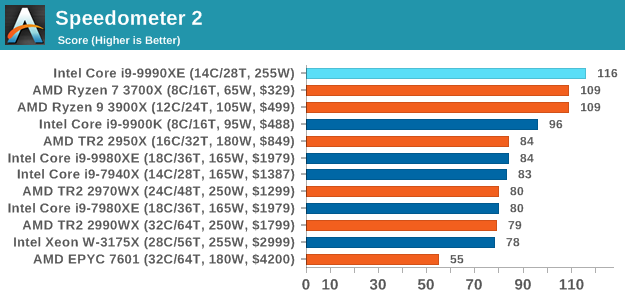
Google Octane 2.0: Core Web Compute
A popular web test for several years, but now no longer being updated, is Octane, developed by Google. Version 2.0 of the test performs the best part of two-dozen compute related tasks, such as regular expressions, cryptography, ray tracing, emulation, and Navier-Stokes physics calculations.
The test gives each sub-test a score and produces a geometric mean of the set as a final result. We run the full benchmark four times, and average the final results.
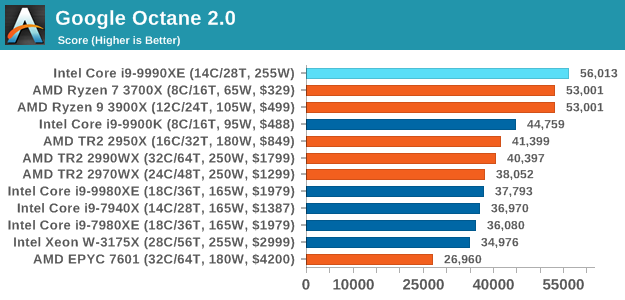
Mozilla Kraken 1.1: Core Web Compute
Even older than Octane is Kraken, this time developed by Mozilla. This is an older test that does similar computational mechanics, such as audio processing or image filtering. Kraken seems to produce a highly variable result depending on the browser version, as it is a test that is keenly optimized for.
The main benchmark runs through each of the sub-tests ten times and produces an average time to completion for each loop, given in milliseconds. We run the full benchmark four times and take an average of the time taken.
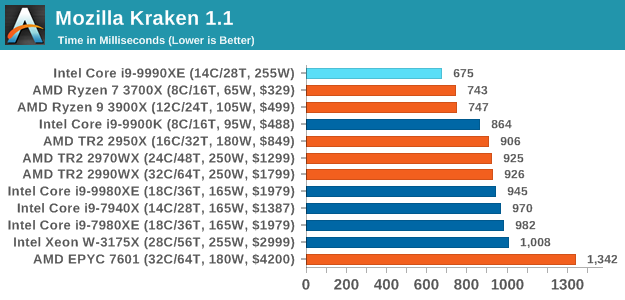
3DPM v1: Naïve Code Variant of 3DPM v2.1
The first legacy test in the suite is the first version of our 3DPM benchmark. This is the ultimate naïve version of the code, as if it was written by scientist with no knowledge of how computer hardware, compilers, or optimization works (which in fact, it was at the start). This represents a large body of scientific simulation out in the wild, where getting the answer is more important than it being fast (getting a result in 4 days is acceptable if it’s correct, rather than sending someone away for a year to learn to code and getting the result in 5 minutes).
In this version, the only real optimization was in the compiler flags (-O2, -fp:fast), compiling it in release mode, and enabling OpenMP in the main compute loops. The loops were not configured for function size, and one of the key slowdowns is false sharing in the cache. It also has long dependency chains based on the random number generation, which leads to relatively poor performance on specific compute microarchitectures.
3DPM v1 can be downloaded with our 3DPM v2 code here: 3DPMv2.1.rar (13.0 MB)
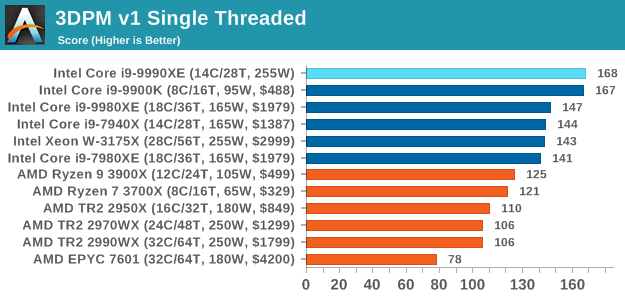
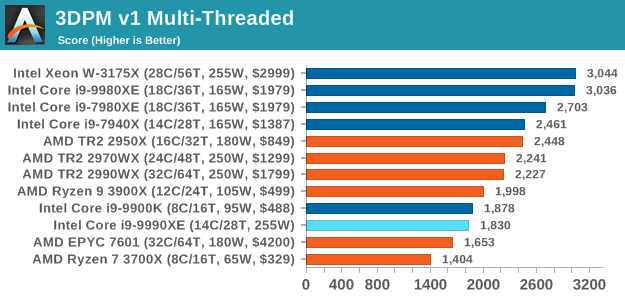
x264 HD 3.0: Older Transcode Test
This transcoding test is super old, and was used by Anand back in the day of Pentium 4 and Athlon II processors. Here a standardized 720p video is transcoded with a two-pass conversion, with the benchmark showing the frames-per-second of each pass. This benchmark is single-threaded, and between some micro-architectures we seem to actually hit an instructions-per-clock wall.
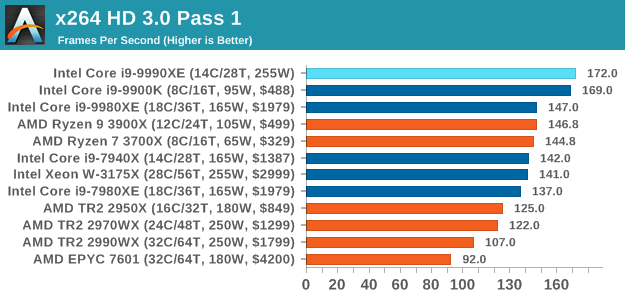
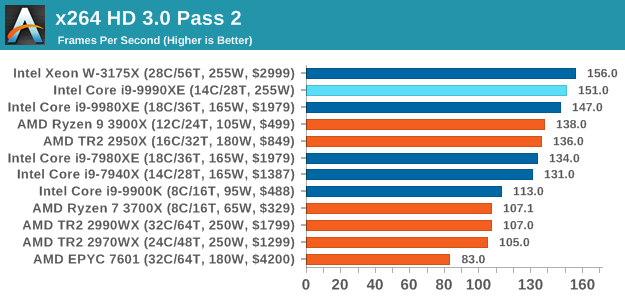










145 Comments
View All Comments
DazFG - Tuesday, October 29, 2019 - link
Would like to see a average performance/Watt chart.abufrejoval - Tuesday, October 29, 2019 - link
The older 3Dmark physics tests don't scale to all available processor cores, so those numbers are misleading. My observation has been that the newer/more demanding the base benchmark, the wider the physics. So e.g. I doubt that Ice Storm actually scores beyond 4 physical cores, while I have seen the physics benchmark correllating to the DX12 graphics (keep forgetting the name) actually pushed all 18 cores in my workstation. I run HWinfo on a secondary screen to monitor what's happening on the system and it cleary reflects that most cores aren't used on these CPU-only physics tests.abufrejoval - Tuesday, October 29, 2019 - link
1.290V at 5 GHz all core may be "amazing" but it should really be "expected": Any chip that requires more voltage and thus power to push electrons through layer interconnects will fail the binning because of heat. And with every little part of 14 cores and their caches needing to qualify, it's easy to see how rare these are.DixonSoftwareSolutions - Tuesday, October 29, 2019 - link
I'm still holding out for the i9-9999XE.Hifihedgehog - Tuesday, October 29, 2019 - link
Agreeing to disagree with you, Ian, after seeing the benchmark results, I would hardly call this the slam dunk and beast it is made out to be. It is good in several benchmarks but it is highly specialized to the point I would argue the 9900KS would be the better choice of the two in nearly all cases for high frequency applications and the 3900X (and by extension 3950X) in multi-core applications. All in all, I am not really impressed and even less so with Threadripper 3000 and Cascade Lake on the verge of release.lejeczek - Tuesday, October 29, 2019 - link
Who cares about tests done on Windows? Who would bother with Chrome compilation on Windows?? Author(s) sees that increasingly more tests are being done with Open Source and clumsily tries to mimic that. But for those interested in real testing - go to phoronix.com and openbenchmarking.orgLots love, xxx.
Urufu - Tuesday, October 29, 2019 - link
Not interested because that's not the real world that people experience every day when using these microprocessors. My apologies for seeming abrupt.lejeczek - Thursday, October 31, 2019 - link
This certainly will sound abrupt - it's for that tiny little world and tiny people in it - the office?? Step outside for a moment and look at big data, clusters, HPC, all sort of servers & services, also academia! Linux & open source everywhere. Why?Might think... some media streaming, transcoding, codecs, etc. you might need that i9-9990XE beast in the office and for windows - sure if you click once here once there to run something - heavy duty transcoding that's Linux all around the clock.
But if one does only pure 'office' and thinks s/he must have this i9-9990XE - well these are the same sort of people who even today when it makes no financial sense whatsoever(do not mention this is not 'office' cpu), who have been happy to pay hefty taxes to Intel for years, those people will do it anyway, will waste money on it, as they do with anything else I'm sure.
But anyway, 'the office' stuff also we do with Linux, easy.
TEAMSWITCHER - Wednesday, October 30, 2019 - link
There is still a metric-sh*t-ton of software development that happens on Windows.MattZN - Tuesday, October 29, 2019 - link
Did you say 600W under full load? For a single CPU socket and only 14 cores? That isn't a wattage that will beget a limited market. That's a wattage that makes the chip D.O.A. No market. At all. Anywhere. Not for 'high frequency trading' or anything else.-Matt